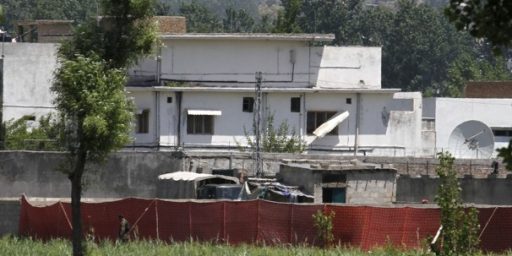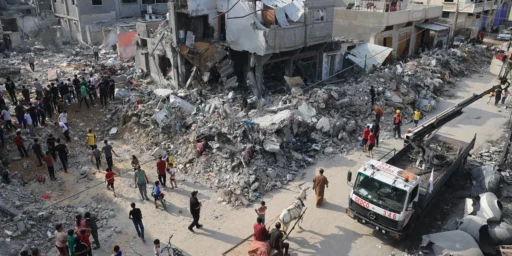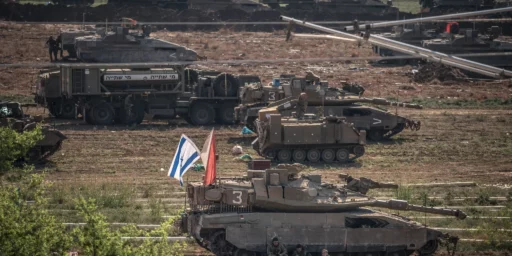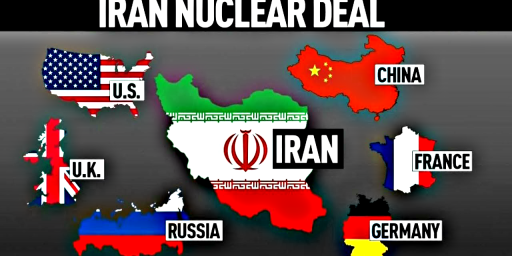Nuking Iran, Redux
Sy Hersh’s New Yorker article claiming that the Bush administration is seriously planning a limited nuclear strike on Iran has spawned several reaction pieces from the mainstream press as well as dozens of blog posts.
Most of the early press pieces were merely “reports” based entirely on the Hersh piece, with this AFP story typical. Others, like the Daily Telegraph‘s Philip Sherwell, at least dug into the paper’s own archives to provide added value.
This newspaper disclosed recently that senior Pentagon strategists are updating plans to strike Iran’s nuclear sites with long-distance B2 bombers and submarine-launched missiles. And last week, the Sunday Telegraph reported a secret meeting at the Ministry of Defence where military chiefs and officials from Downing Street and the Foreign Office discussed the consequences of an American-led attack on Iran, and Britain’s role in any such action.
The military option is opposed by London and other European capitals. But there are growing fears in No 10 and the Foreign Office that the British-led push for a diplomatic solution to the Iranian nuclear stand-off, will be swept aside by hawks in Washington. Hersh says that within the Bush administration, there are concerns that even a pummelling by conventional strikes, may not sufficiently damage Iran’s buried nuclear plants.
Iran has been developing a series of bunkers and facilities to provide hidden command centres for its leaders and to protect its nuclear infrastructure. The lack of reliable intelligence about these subterranean facilities, is fuelling pressure for tactical nuclear weapons to be included in the strike plans as the only guaranteed means to destroy all the sites simultaneously.
Perhaps most interesting is a front page piece in today’s WaPo by Peter Baker, Dafna Linzer and Thomas E. Ricks that goes several paragraphs before it mentions Hersh at all. It is unclear from the writing whether the “U.S. officials and independent analysts” to whom they attribute the story are their own or merely those quoted by Hersh. As one reads the story, though, almost all of it is just a repackaging of Hersh’s work with some historical background thrown in, yet the quotes are presented as if they were original reporting by the Post rather than from Hersh’s piece.
They do at least get some expert reaction quotes.
Many military officers and specialists, however, view the saber rattling with alarm. A strike at Iran, they warn, would at best just delay its nuclear program by a few years but could inflame international opinion against the United States, particularly in the Muslim world and especially within Iran, while making U.S. troops in Iraq targets for retaliation. “My sense is that any talk of a strike is the diplomatic gambit to keep pressure on others that if they don’t help solve the problem, we will have to,” said Kori Schake, who worked on Bush’s National Security Council staff and teaches at the U.S. Military Academy at West Point, N.Y.
Others believe it is more than bluster. “The Bush team is looking at the viability of airstrikes simply because many think airstrikes are the only real option ahead,” said Kurt Campbell, a former Pentagon policy official.
Much later in the piece, though, we get some valuable insights.
The British government has launched its own planning for a potential U.S. strike, studying security arrangements for its embassy and consular offices, for British citizens and corporate interests in Iran and for ships in the region and British troops in Iraq. British officials indicate their government is unlikely to participate directly in any attacks.
Israel is preparing, as well. The government recently leaked a contingency plan for attacking on its own if the United States does not, a plan involving airstrikes, commando teams, possibly missiles and even explosives-carrying dogs. Israel, which bombed Iraq’s Osirak nuclear plant in 1981 to prevent it from being used to develop weapons, has built a replica of Natanz, according to Israeli media, but U.S. strategists do not believe Israel has the capacity to accomplish the mission without nuclear weapons.
Iran appears to be taking the threat seriously. The government, which maintains its nuclear activity is only for peaceful, civilian uses, has launched a program to reinforce key sites, such as Natanz and Isfahan, by building concrete ceilings, tunneling into mountains and camouflaging facilities. Iran lately has tested several missiles in a show of strength.
Israel points to those missiles to press their case in Washington. Israeli officials traveled here recently to convey more urgency about Iran. Although U.S. intelligence agencies estimate Iran is about a decade away from having a nuclear bomb, Israelis believe a critical breakthrough could occur within months. They told U.S. officials that Iran is beginning to test a more elaborate cascade of centrifuges, indicating that it is further along than previously believed. “What the Israelis are saying is this year — unless they are pressured into abandoning the program — would be the year they will master the engineering problem,” a U.S. official said. “That would be a turning point, but it wouldn’t mean they would have a bomb.”
[…]
Unlike the Israeli air attack on Osirak, a strike on Iran would prove more complex because Iran has spread its facilities across the country, guarded some of them with sophisticated antiaircraft batteries and shielded them underground. Pentagon planners are studying how to penetrate eight-foot-deep targets and are contemplating tactical nuclear devices. The Natanz facility consists of more than two dozen buildings, including two huge underground halls built with six-foot walls and supposedly protected by two concrete roofs with sand and rocks in between, according to Edward N. Luttwak, a specialist at the Center for Strategic and International Studies. “The targeteers honestly keep coming back and saying it will require nuclear penetrator munitions to take out those tunnels,” said Kenneth M. Pollack, a former CIA analyst. “Could we do it with conventional munitions? Possibly. But it’s going to be very difficult to do.”
Indeed, essentially impossible.





